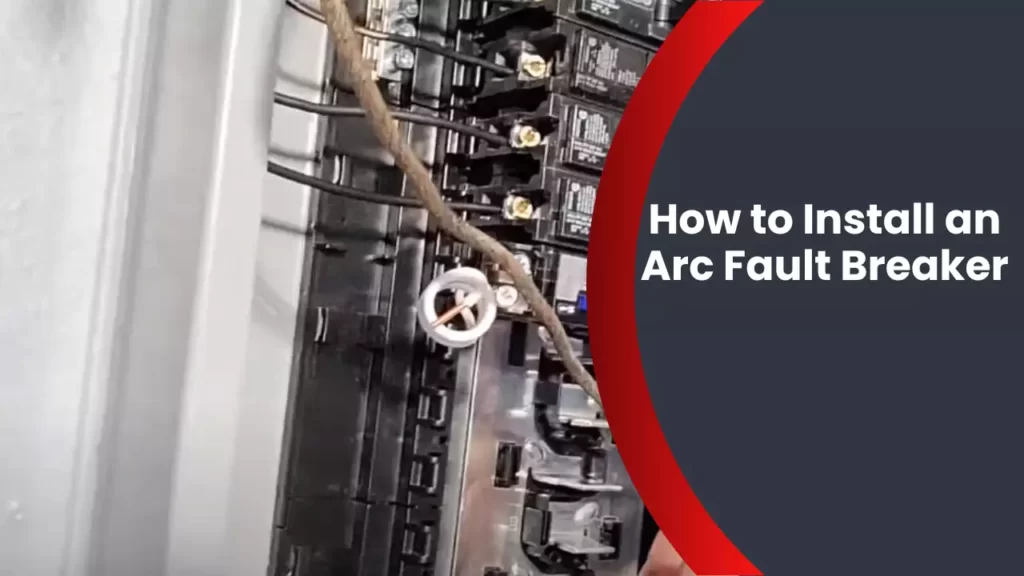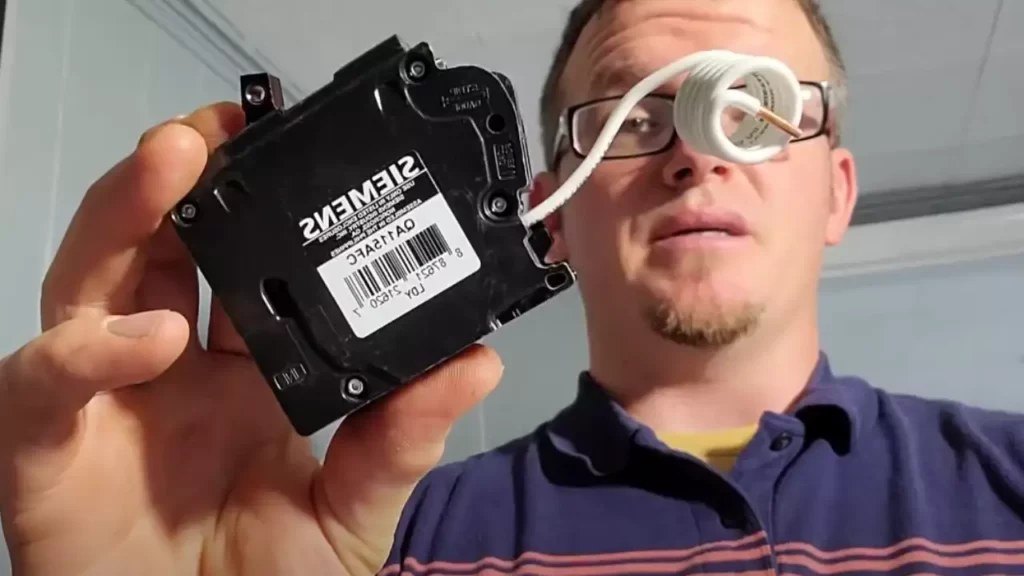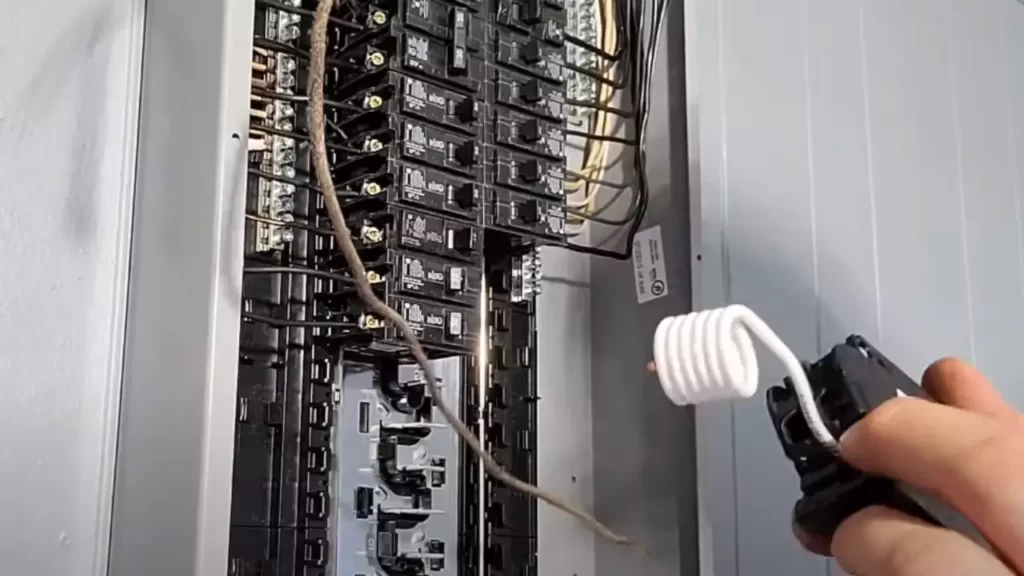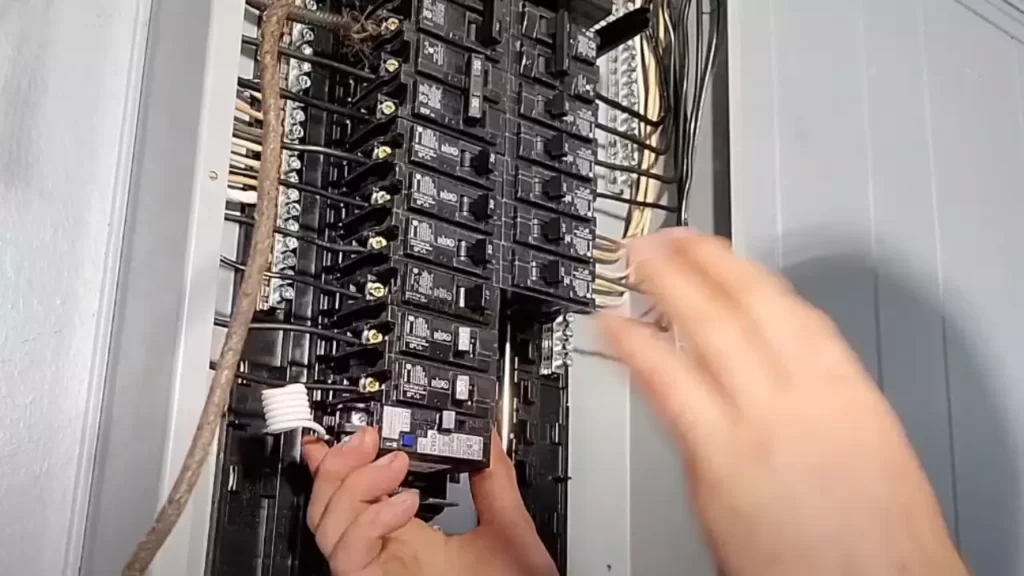To install an arc fault breaker, turn off the main power, remove the panel cover, and snap the breaker into an available slot, then connect the circuit wires to the breaker and secure them with screws. An arc fault breaker acts as a crucial safety feature in your electrical system, helping to prevent fires caused by electrical arcs.
By detecting abnormal arcing, it shuts off the power to the affected circuit, reducing the risk of fire. Installing an arc fault breaker is a relatively simple process that can enhance the safety of your home’s electrical system. We will guide you through the step-by-step process of installing an arc fault breaker, ensuring that you can do it correctly and safely.
Why Install An Arc Fault Breaker?
Installing an arc fault breaker is a crucial step in ensuring the safety of your electrical system. It helps protect against electrical fires caused by arc faults and reduces the risk of potential hazards. In this article, we will explore the importance of installing an arc fault breaker and why it should be a priority for every homeowner.
Protects against electrical fire
An arc fault breaker plays a vital role in safeguarding your home from electrical fire hazards. Electrical arcing is a common phenomenon that occurs when there is a loose connection, damaged wiring, or faulty electrical equipment. This arcing can generate intense heat and can easily ignite surrounding materials, leading to a potentially devastating fire.
By installing an arc fault breaker, you create an additional layer of protection against these electrical fires. The breaker is designed to detect any abnormal electrical arcing and immediately cut off power to that specific circuit, preventing any potential fire risk. Its prompt response can significantly minimize the chances of a fire breaking out and provide you and your family with priceless peace of mind.
Reduces the risk of arc faults
Arc faults are a common cause of electrical fires and can occur due to various factors, including damaged insulation, loose connections, and frayed wires. These faults can go unnoticed until they cause a significant issue, making them an invisible threat to your home’s safety.
By installing an arc fault breaker, you can greatly reduce the risk of arc faults in your electrical system. The breaker continuously monitors the flow of electricity through the circuits and can quickly detect any irregularities that indicate an arc fault. Once detected, it trips the breaker, cutting off the power supply and minimizing the potential damage that an arc fault can cause.
In addition to reducing the risk of fire, an arc fault breaker also helps in identifying potential problems within your electrical system. If the breaker trips frequently, it serves as a clear indication that there may be underlying issues that need to be addressed by a qualified electrician.
Overall, installing an arc fault breaker is a proactive measure in preventing electrical fires and ensuring the safety of your home and loved ones. Investing in this safety feature not only provides protection against fire-related hazards but also acts as an early warning system for potential electrical issues. Make it a priority to install one in your home today and give yourself the peace of mind you deserve.

Understanding Arc Fault Breakers
Arc fault breakers are an essential component of any electrical system, providing protection against dangerous electrical arcing. In this section, we will delve into the definition, function, and how arc fault breakers differ from regular circuit breakers.
Definition and Function
An arc fault breaker, also known as an arc fault circuit interrupter (AFCI), is a specialized type of circuit breaker designed to detect and protect against electrical arcs. These arcs occur when a current flows through an unintended path, such as damaged or exposed wiring, faulty equipment, or loose connections.
The primary function of an arc fault breaker is to prevent electrical fires by quickly interrupting the circuit when an arc fault is detected. By sensing the unique characteristics of arcing, such as the rapid fluctuations in current and voltage, the AFCI breaker can swiftly respond and cut off the power supply to the affected circuit.
How They Differ from Regular Circuit Breakers
Arc fault breakers differ from regular circuit breakers in their ability to detect and respond to arc faults specifically. While traditional circuit breakers protect against overloads and short circuits, they do not possess the advanced technology necessary to detect and address arc faults.
Regular circuit breakers rely on thermal or magnetic sensors to trip the circuit when excessive current or a short circuit occurs. On the other hand, arc fault breakers incorporate sophisticated electronics, including microprocessors and algorithms, to analyze the electrical waveforms and identify the unique signature of an arc fault.
By distinguishing between harmless arcs, such as those produced by appliances like vacuums or power tools, and dangerous arcs that may lead to fires, arc fault breakers minimize unnecessary interruptions while maintaining a high level of safety.
It is vital to note that as per electrical code requirements, arc fault breakers are typically required for circuits serving bedrooms, living rooms, and other areas where potential fire hazards may exist owing to the usage of certain appliances or the presence of flammable materials.

Steps To Install An Arc Fault Breaker
Installing an arc fault breaker is an important step in ensuring the safety of your electrical circuit. Arc faults can occur when there is a breakdown in the electrical flow, which can lead to overheating and potentially cause a fire. By installing an arc fault breaker, you can detect and protect against these dangerous faults. In this guide, we will walk you through the steps to safely and correctly install an arc fault breaker.
Gathering the necessary tools and materials
Before you begin the installation process, it is important to gather all the necessary tools and materials. Here’s a list of what you’ll need:
| Materials: | Tools: |
| – Arc fault breaker | – Screwdriver |
| – Wire cutters | – Wire strippers |
| – Wire nuts | – Voltage tester |
| – Electrical tape | – Safety goggles |
Shutting off power to the circuit
Before you begin working on any electrical installation, it is crucial to turn off the power to the circuit you’ll be working on. This step will ensure your safety and prevent any potential accidents. Follow these steps to shut off the power:
- Locate the main electrical panel in your home.
- Open the panel cover using a screwdriver.
- Identify the breaker that controls the circuit you’ll be working on.
- Flip the breaker switch to the “off” position.
- Use a voltage tester to double-check that the power is off.
Removing the old breaker
With the power off, you can now proceed to remove the old breaker. Follow these steps:
- Use a screwdriver to remove the screws securing the breaker in place.
- Gently pull the breaker away from the panel, disconnecting the wires.
- Set the old breaker aside.
Installing the new arc fault breaker
Now it’s time to install the new arc fault breaker. Follow these steps:
- Position the new arc fault breaker in the panel.
- Line up the breaker’s connection points with the panel’s bus bars.
- Slide the breaker into place and secure it with the screws.
- Ensure that the breaker is tightly and securely fastened.
Connecting the wiring
Now that you have the new breaker in place, you can connect the wiring. Follow these steps:
- Strip the insulation from the end of each wire.
- Use wire nuts to securely connect the wires to the breaker.
- Make sure the connections are tight and there is no exposed wire.
- Wrap electrical tape around the wire nuts for added protection.
Testing the breaker
After completing the installation, it is important to test the breaker to ensure everything is working correctly. Follow these steps:
- Turn the power back on to the circuit.
- Using a voltage tester, check that the breaker is receiving power.
- Test the circuit by turning on lights or appliances connected to it.
- If everything is functioning properly, you have successfully installed the arc fault breaker.
By following these steps, you can safely and confidently install an arc fault breaker, enhancing the safety of your electrical system and protecting against potentially hazardous arc faults.

Additional Considerations
When it comes to installing an arc fault breaker, there are a few additional considerations to keep in mind. These considerations will help ensure that your installation is done correctly and safely. In this section, we will discuss the importance of choosing the right type of arc fault breaker, adhering to local electrical codes, and seeking professional help if needed.
Choosing the right type of arc fault breaker
When selecting an arc fault breaker, it is crucial to choose the right type for your specific needs. There are two main types to consider:
- Combination type: This type of arc fault breaker not only detects series, parallel, and ground arc faults but also provides standard overcurrent protection. It is typically recommended for new installations or when upgrading an existing electrical system.
- Branch/feeder type: This type only detects parallel and ground arc faults. It is suitable for retrofitting into existing electrical panels.
Consulting with a licensed electrician can help you determine which type is most appropriate for your situation. They will consider factors such as the age of your electrical system, the type of wiring used, and any specific requirements set by local electrical codes.
Adhering to local electrical codes
Electrical codes exist to ensure the safety of individuals and property. It is crucial to adhere to local electrical codes when installing an arc fault breaker or making any electrical modifications. Failing to do so can result in serious consequences, including electrical hazards and code violations.
To ensure compliance with local electrical codes, you can:
- Research the specific requirements of your area
- Consult with a licensed electrician
- Obtain any necessary permits
- Follow the instructions provided by the manufacturer of the arc fault breaker
By taking these measures, you can ensure that your installation meets the necessary safety standards and complies with all applicable regulations.
Seeking professional help if needed
Installing an arc fault breaker can be a complex task, especially for those without electrical experience. If you are unsure or uncomfortable with the installation process, it is highly recommended to seek the assistance of a licensed electrician.
A professional electrician has the knowledge and expertise to ensure that the arc fault breaker is installed correctly and safely. They can evaluate your electrical system, determine the appropriate type of arc fault breaker, and complete the installation in compliance with local electrical codes.
Remember, the safety of your home and family should always be a top priority. Investing in the expertise of a professional can provide you with the peace of mind that your arc fault breaker is installed properly, reducing the risk of electrical hazards and ensuring the protection of your electrical system.

Common Issues And Troubleshooting
Tripping of the arc fault breaker
One common issue that homeowners may experience when installing an arc fault breaker is that it might trip frequently. This can be quite frustrating, but it is essential to understand the reasons behind this problem.
One of the main causes of tripping is excessive electrical current flowing through the circuit. This could be due to overloading the circuit with too many appliances or devices. It’s crucial to make sure that the total electrical load of the circuit does not exceed the maximum capacity of the arc fault breaker.
Another cause of tripping is a short circuit or ground fault. These occur when there is an unintended connection between the hot wire and the neutral wire or the ground wire. It’s vital to identify and fix any faulty wiring or damaged insulation that may be causing these issues.
Retrofitting older homes with arc fault breakers
If you live in an older home, you may be wondering if it’s possible to install arc fault breakers to enhance the safety of your electrical system. The good news is that it is indeed possible!
Retrofitting older homes with arc fault breakers involves replacing the existing circuit breakers with the newer AFCI (Arc Fault Circuit Interrupter) type. These breakers can detect and trip in response to arc faults, minimizing the risk of electrical fires.
However, retrofitting older homes with arc fault breakers may present some unique challenges. One primary concern is the compatibility of the existing electrical system with the newer AFCI breakers. It’s essential to ensure that the electrical panel can accommodate the AFCI breakers and that the wiring is compatible.
Additionally, older homes may have wiring that is not up to current electrical code standards. This may require updating the wiring to meet safety requirements before installing the arc fault breakers.
It’s crucial to consult a qualified electrician who specializes in retrofitting older homes with arc fault breakers. They will be able to assess your electrical system, provide guidance on code compliance, and ensure a proper installation.
Safety Precautions
Before you begin installing an arc fault breaker, it is crucial to prioritize your safety. By taking a few precautions, you can ensure a smooth and hazard-free installation process. Here are some key safety measures to keep in mind:
Wearing protective gear
To safeguard yourself from any potential harm, it is essential to wear the appropriate protective gear. This includes safety goggles to shield your eyes from debris and sparks, as well as work gloves to protect your hands.
Working with caution
Working with electricity requires caution and attentiveness. Always make sure to turn off the power supply to the circuit you will be working on. This can be done by flipping the circuit breaker to the “off” position. Additionally, use a voltage tester to confirm that there is no current running through the wires.
When handling electrical components, such as the arc fault breaker, handle them with care and avoid applying excessive force. Be mindful of any loose wires and secure them properly to prevent accidental disconnections. Pay close attention to the manufacturer’s instructions for a correct and safe installation.
Seeking assistance when necessary
If you are unsure about any step during the arc fault breaker installation, always seek assistance. Consulting with a professional electrician can offer valuable guidance and ensure that the installation is carried out correctly and to code. It is better to seek help from an expert than to risk personal injury or damage to your electrical system.
Remember, safety should never be compromised. By following these safety precautions, you can confidently proceed with the arc fault breaker installation, ensuring the security of your electrical system and your well-being.
Frequently Asked Questions
Where Do Arc Fault Breakers Need To Be Installed?
Arc fault breakers need to be installed in areas where electrical arcs may occur, such as bedrooms, living rooms, and dining rooms. These breakers provide protection against electrical fires caused by arcing faults, ensuring the safety of your home and its occupants.
When Should Arc Fault Breaker Be Installed?
Arc fault breakers should be installed in residential properties during construction or renovation to enhance electrical safety. These breakers detect dangerous electrical arcs and disconnect power to prevent fires. Installing arc fault breakers ensures compliance with electrical codes and protects occupants from potential hazards.
Do Arc Fault Breakers Require A Ground Wire?
Arc fault breakers do not require a ground wire. They are designed to detect and protect against electrical arcs, not faults to ground. However, it is still important to have a proper grounding system in place to ensure safety and prevent electrical fires.
Make sure to consult an electrician for guidance on installing arc fault breakers.
How Much Does It Cost To Install An Arc Fault Breaker?
The cost of installing an arc fault breaker can vary depending on factors such as the brand, amperage, and complexity of the electrical system. Generally, the cost can range from $100 to $250 for just the breaker itself, with additional costs for labor and any necessary electrical modifications.
Conclusion
Installing an arc fault breaker is a crucial step in ensuring the safety of your electrical system. By following the step-by-step instructions outlined in this guide, you can confidently make this upgrade to protect your home from dangerous electrical arcs.
Remember to always prioritize safety and consult a professional if you encounter any difficulties during the installation process. Don’t delay in safeguarding your home and loved ones from potential electrical hazards.
